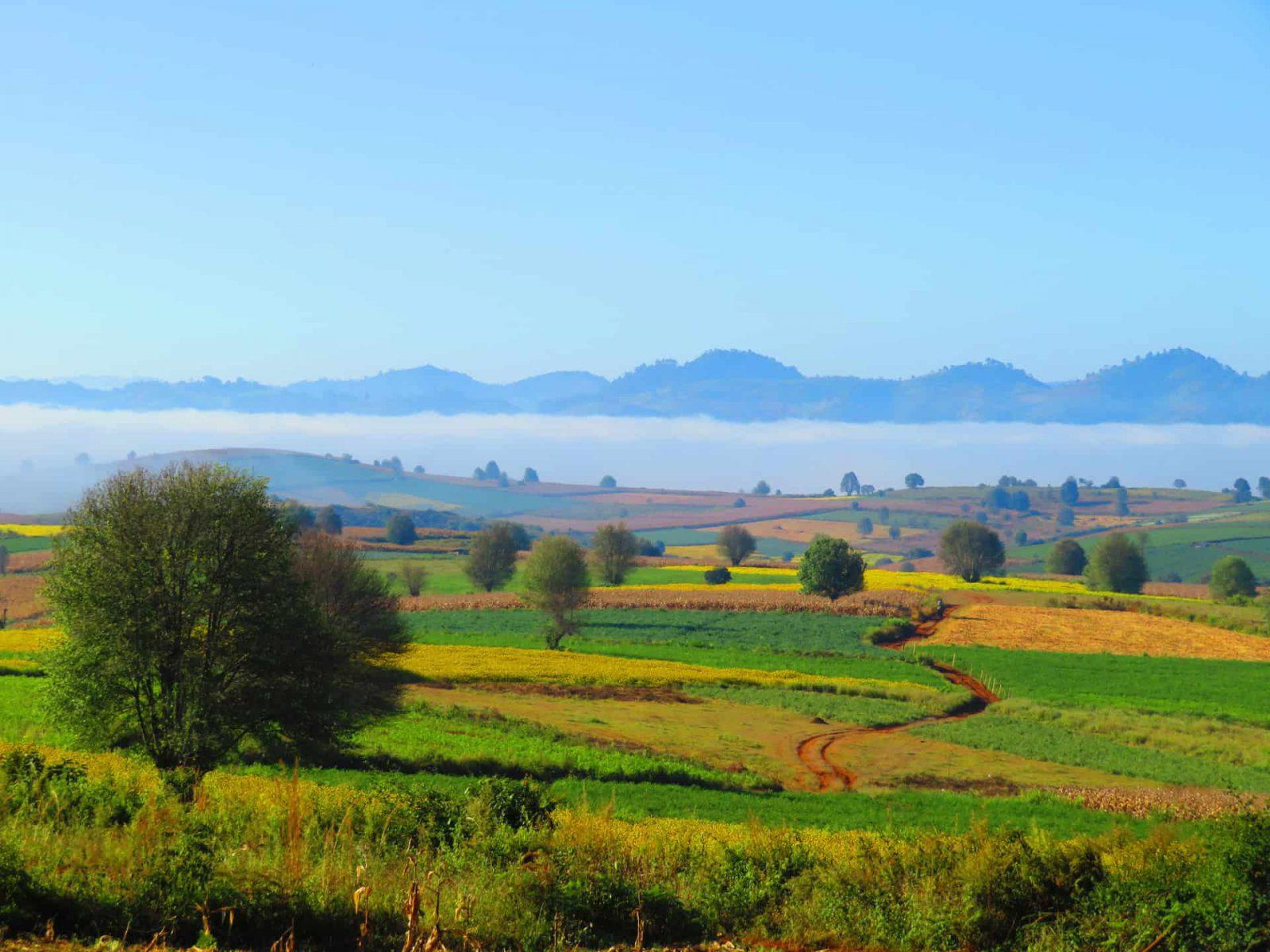Top Things to Do in Kalaw, Myanmar’s Cool Mountain Retreat
Introduction to Kalaw
Perched high in the scenic Shan Hills, the former British hill station of Kalaw offers a breath of fresh air — both literally and figuratively. With its colonial charm, pine forests, rolling green hills, and vibrant ethnic communities, Kalaw has become Myanmar’s most popular base for trekking to Inle Lake, while still retaining its quiet, off-the-beaten-path charm.

Here, you’ll walk alongside farmers tending to tea fields, monks descending forest paths, and children playing beneath giant banyan trees. Kalaw is not just a place — it’s a slower pace of life, wrapped in the cool mist of mountain mornings.
Whether you’re an avid trekker, culture lover, or laid-back wanderer, Kalaw promises an unforgettable stay.
📍 Where is Kalaw?
Kalaw is located in Shan State, eastern Myanmar. It sits at an altitude of about 1,300 meters (4,265 ft), giving it a cool climate year-round.
Key Distances:
From Heho Airport: 30 km (about 1 hour)
From Inle Lake (Nyaung Shwe): 60 km (about 2 hours by car or 3-day trek)
From Mandalay: ~275 km (7-8 hours by bus or train)
From Yangon: ~620 km (10-12 hours by overnight bus)
🛣️ How to Get to Kalaw
✈️ By Air:
Heho Airport is the nearest airport.
Daily domestic flights from Yangon, Mandalay, and Bagan.
From Heho, take a 1-hour taxi or shared transport to Kalaw.
🚌 By Bus:
Overnight buses run from Yangon, Mandalay, and Bagan to Kalaw.
Buses are modern and comfortable, with semi-sleeper options.
🚂 By Train:
The scenic train ride from Thazi to Kalaw is slow but stunning — passing through tunnels, mountains, and rice fields.
Tip: Travel light if you plan to trek, and book tickets in advance during peak season (Nov–Feb).
🧭 Things to Do in Kalaw
1. Trekking to Inle Lake
Kalaw is Myanmar’s trekking capital, with trails leading through:
Ethnic Pa-O, Danu, Palaung, and Taung Yo villages
Green tea plantations and rice paddies
Rolling hills and quiet monasteries
Popular Trekking Options:
3-Day Trek to Inle Lake (most popular)
2-Day/1-Night Trek with village stay
Day Hikes to nearby villages like Myin Ma Hti or Pattu village
You’ll sleep in local homes or monasteries, eat traditional meals, and enjoy meaningful interactions with locals.
Tip: Hire a certified local guide for authentic experiences and better route knowledge.
2. Visit the Local Market
The Kalaw morning market is a sensory delight where locals gather to buy:
Fresh produce
Mountain herbs
Handwoven textiles
Shan noodles and snacks
Every 5th day, hill tribe people come from surrounding villages, turning the market into a vibrant cultural event.
3. Explore the Kalaw Railway Station
A charming colonial-era station, it’s quiet and nostalgic, with old trains slowly chugging through the pine-scented hills. Great for photos or catching the scenic train to Thazi.
4. Hike to Thein Taung Monastery
Located on a hill overlooking Kalaw town, this peaceful monastery offers:
Stunning sunrise and sunset views
A quiet atmosphere for meditation
A great first hike to stretch your legs
5. Visit Hnee Pagoda (Shwe Oo Min Pagoda)
Home to a 500-year-old bamboo Buddha, this sacred site is nestled inside a limestone cave. A calm spot that locals hold in high spiritual regard.
6. Sample Kalaw’s Coffee and Tea
The region is known for its organic coffee and Shan tea. Visit:
Sprouting Seeds Café: Youth-run with ethical coffee and food
Hi Snack & Drink: A cozy place for traditional desserts and drinks
Ever Smile Café: Best for mountain views and a relaxed vibe
🧭 Day Trips Around Kalaw
1. Green Hill Valley Elephant Camp
A responsible sanctuary where retired elephants are cared for — no riding involved. You can:
Feed and bathe elephants
Learn about conservation efforts
Plant a tree as part of their reforestation program
2. Pindaya Caves
Only 90 minutes from Kalaw, these spectacular caves house 8,000+ Buddha statues in a dramatic limestone setting.
🏨 Where to Stay in Kalaw
From boutique hotels to eco-lodges, Kalaw caters to various budgets and preferences.
Recommended Options:
Kalaw Heritage Hotel – Colonial elegance with garden views
Dream Mountain Resort – Spectacular panoramas and trekking info
Thitaw Lay House – Family-run guesthouse with local charm
Nature Land Hotel II – Clean, budget-friendly, and centrally located
Book early during the cool season (Nov–Feb) and Kalaw Festival months.
🍜 What to Eat in Kalaw
Kalaw’s cuisine is influenced by Shan, Burmese, Indian, and Nepalese flavors.
Must-Try Dishes:
Shan Tofu Nway (Warm tofu noodle soup)
Nepali-style momo dumplings
Tea leaf salad (Lahpet Thoke)
Grilled eggplant curry
Bamboo shoot stir-fry
Many cafes in Kalaw are vegetarian and vegan-friendly.
📅 Best Time to Visit Kalaw
November to February: Cool, dry, perfect for trekking (avg. 15–25°C)
March to May: Hotter but still manageable
June to October: Rainy season, muddy trails but lush scenery
Kalaw Fire Balloon Festival (around November) is a smaller version of the one in Taunggyi — worth seeing if you’re lucky with timing!
🎒 Travel Tips for Kalaw
Bring warm layers: Nights can get cold, especially during winter.
Good walking shoes: Essential for hiking uneven trails.
Respect local customs: Especially in monasteries and ethnic villages.
Bring cash: ATMs are available but not always reliable.
Use local guides: Support the community and gain cultural insights.
📷 Best Photo Spots in Kalaw
Sunrise at Thein Taung Monastery
Sunset over the rolling hills from your guesthouse terrace
Villages along trekking trails
Colorful market scenes
Elephant moments at Green Hill Valley
🌿 Why Visit Kalaw?
Kalaw is more than a pit stop before Inle Lake. It’s a destination that whispers stories of the past and invites you to walk its hills at your own pace. With authentic village life, cool climate, peaceful monasteries, and soulful trekking, Kalaw is a refreshing contrast to Myanmar’s bustling lowlands.
It is a place where nature, culture, and spirituality meet — not in grandeur, but in quiet, unforgettable harmony.
